Cytoskeleton and Cell Adhesion as Drug Targets
1/147
There's no tags or description
Looks like no tags are added yet.
Name | Mastery | Learn | Test | Matching | Spaced |
|---|
No study sessions yet.
148 Terms
What is the primary focus of the notes dated 04/08/2025?
The Cytoskeleton and Cell Adhesion as Drug Targets.
Who is the author of the notes?
Alan K.
What are the three families of cytoskeletal filaments?
Actin microfilaments, intermediate filaments, and microtubules.
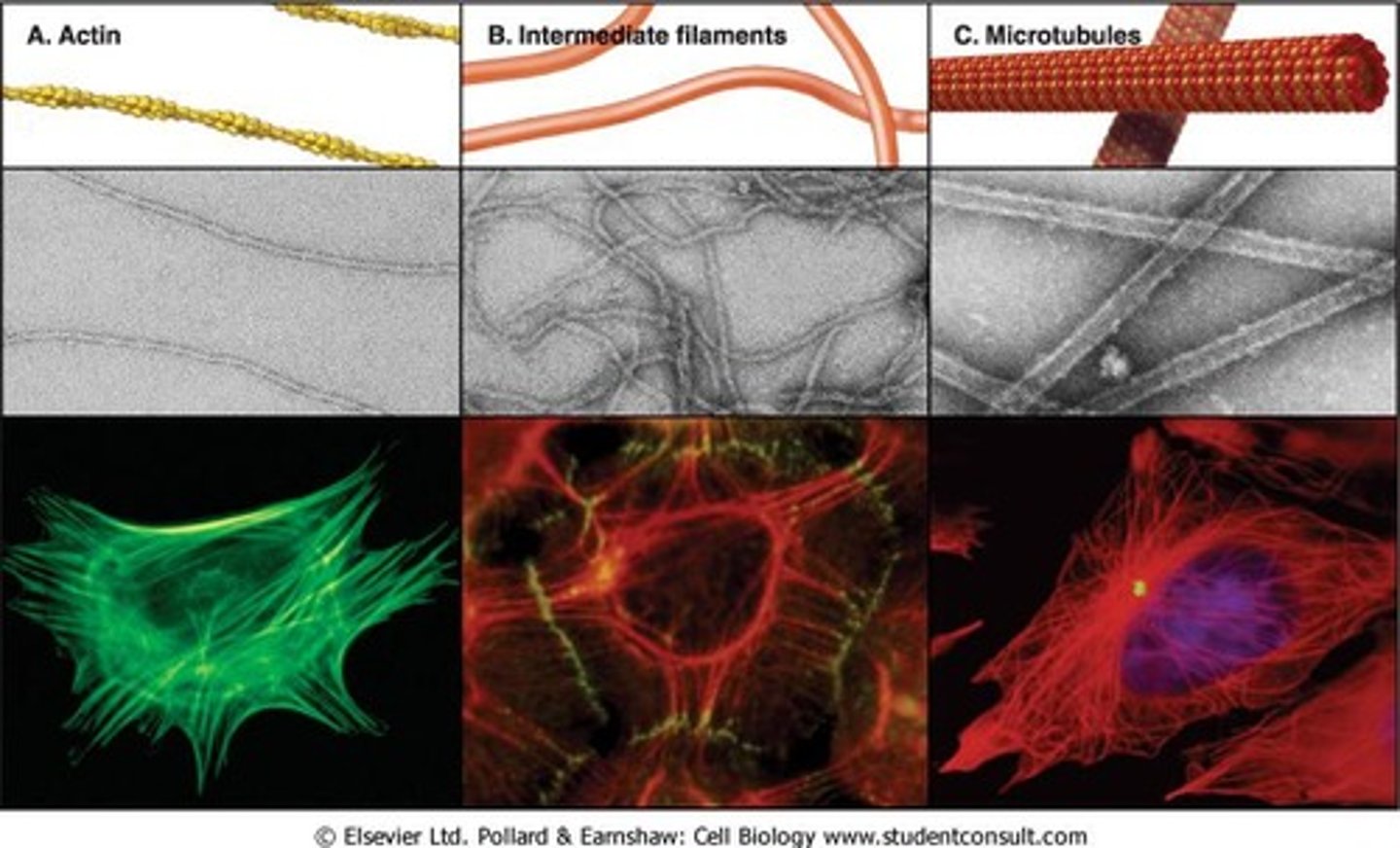
What are the main characteristics of actin microfilaments?
Highly dynamic, flexible, polarized filaments that resist compression and tension, and serve as tracks for myosin motors.
What is the primary function of intermediate filaments?
Provide mechanical support for cells and cell sheets, and contribute to nuclear architecture.
Describe the structure and function of microtubules.
Rigid, hollow, polarized rods that resist compression and tension, and serve as tracks for kinesin and dynein motors.

What types of drugs target microtubules?
Microtubule-targeting drugs include depolymerizers and stabilizers that inhibit microtubule dynamics.
What is the origin of the term 'scurvy'?
Derived from Middle Dutch or Middle Low German, meaning 'disease that lacerates the belly'.
What are the major components of the extracellular matrix (ECM)?
Glycosaminoglycans (GAGs), proteoglycans (PGs), fibrous proteins, and adhesive proteins.
How does cell-ECM adhesion influence cell survival?
Cell-ECM adhesion can prevent DNA fragmentation and apoptosis in normal cells.
What are integrins and their role in cell adhesion?
Integrins are ECM receptors that mediate cell adhesion to the extracellular matrix.
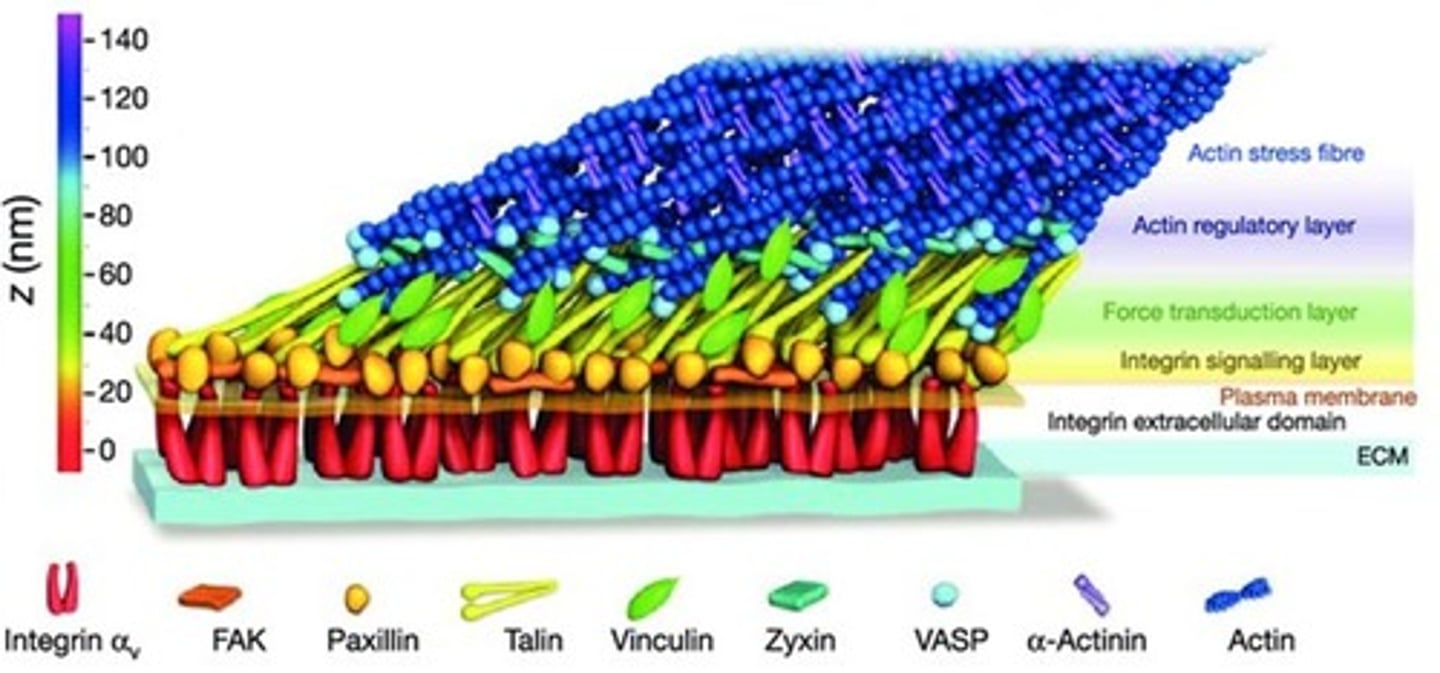
What is the significance of the ECM in solid tissues?
The ECM occupies the extracellular space and is often more abundant than the cells within it.
What are the two classes of cytoskeletal drugs that target microtubules?
Depolymerizers and stabilizers.
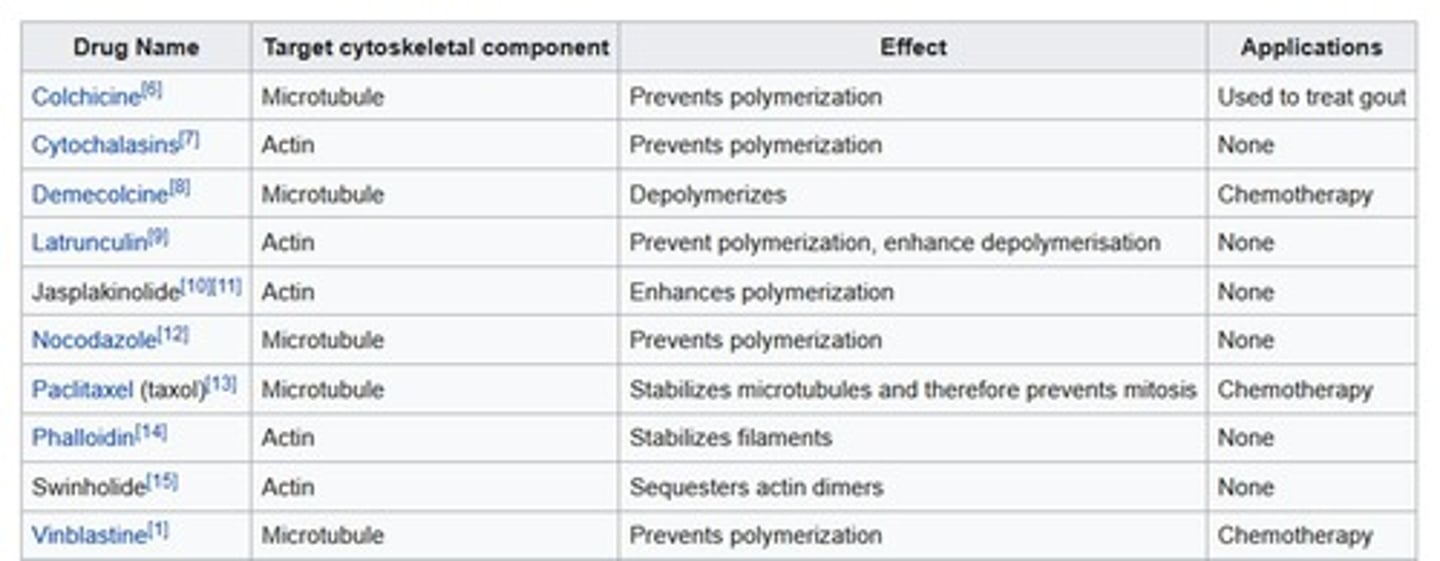
What is the mechanism of action for many cancer chemotherapies related to cell adhesion?
They induce apoptosis through DNA fragmentation caused by cell damage.

What is the role of fibroblasts in ECM composition?
Fibroblasts synthesize, excrete, and organize the components of loose connective tissue ECM.
How does the ECM change over time?
The ECM is dynamic, undergoing assembly, modeling, synthesis, excretion, remodeling, and repair.
What is the relationship between cell adhesion and mitogenic signaling?
Cell-ECM adhesion dramatically influences mitogenic signaling.
What is the role of phalloidin in relation to actin filaments?
Phalloidin binds along the side of actin filaments and stabilizes them.
What are the effects of Death Cap toxicity?
Phase I includes severe GI distress, Phase II is recovery, and Phase III involves hepatic and renal dysfunction and death.
What is the significance of the extracellular matrix's composition?
The composition is dictated by physical and functional requirements such as flexibility, rigidity, fluidity, and strength.
What is the function of GAGs and PGs in the ECM?
They contribute to the structural integrity and function of the extracellular matrix.
What is the role of keratins in intermediate filaments?
Keratins provide mechanical support and can be modified using thioglycolate and hydrogen peroxide.
What happens to normal epithelial cells when they are detached from the ECM?
They may undergo apoptosis due to lack of cell-ECM adhesion.

What is the impact of leukocyte rolling on inflammation?
Leukocyte rolling involves anti-inflammatory integrin antibodies that can modulate immune responses.
What is the ultimate mechanism of action for many cancer chemotherapies?
Induction of apoptosis through cell damage and DNA fragmentation.
What are the three main families of the cytoskeleton?
Actin microfilaments, intermediate filaments, microtubules.
What are the characteristics of actin microfilaments?
Highly dynamic, flexible, polarized filaments that resist compression and tension, and serve as tracks for myosin motors.
What types of drugs target microtubules?
Microtubule drugs are classified into depolymerizers and stabilizers that inhibit microtubule dynamics.
What is phalloidin and its effect on actin filaments?
Phalloidin binds along the side of actin filaments and stabilizes them.
What are the phases of Death Cap toxicity caused by phallotoxins?
Phase I: Severe GI distress; Phase II: Recovery; Phase III: Hepatic & renal dysfunction leading to death.
What is the role of cell-ECM adhesion in cell survival?
Cell-ECM adhesion influences cell survival by affecting mitogenic signaling and apoptosis.
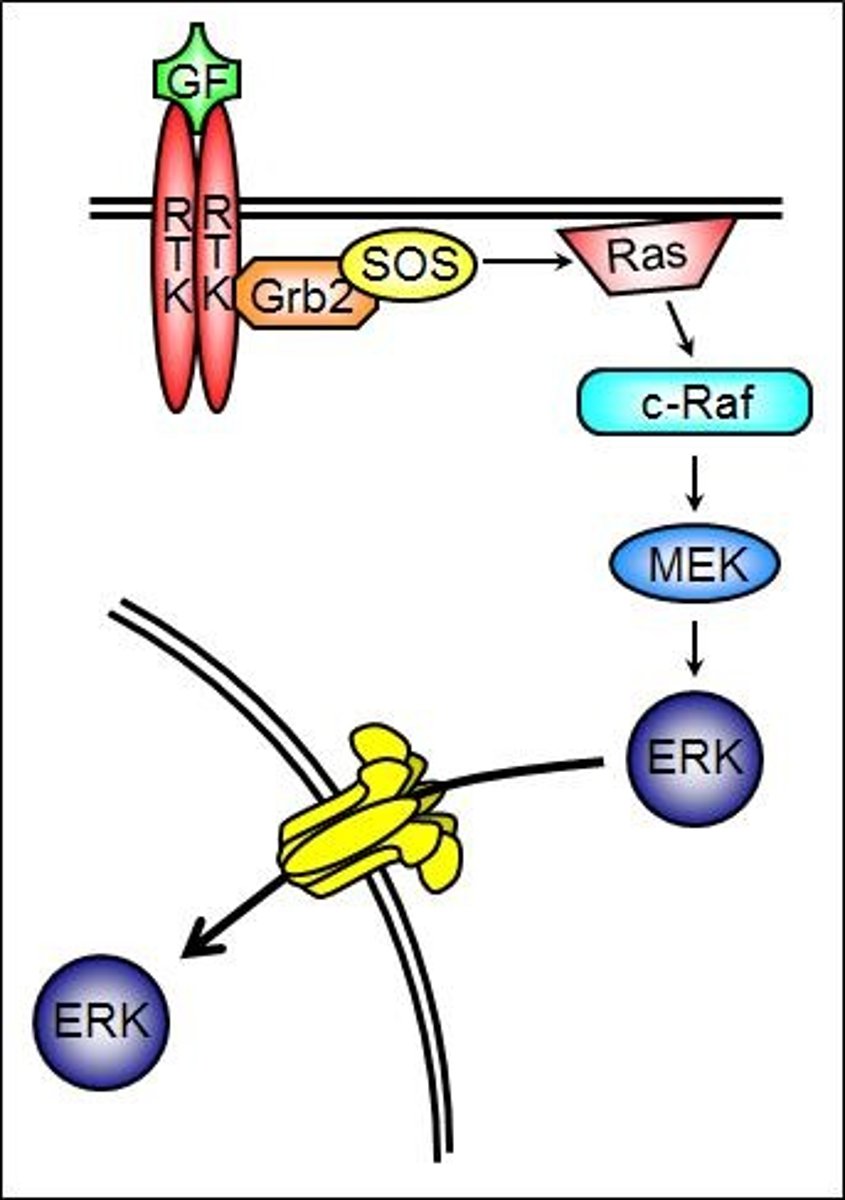
What is the extracellular matrix (ECM)?
A network of large macromolecules that occupies the extracellular space in solid tissues, often more abundant than the cells within it.
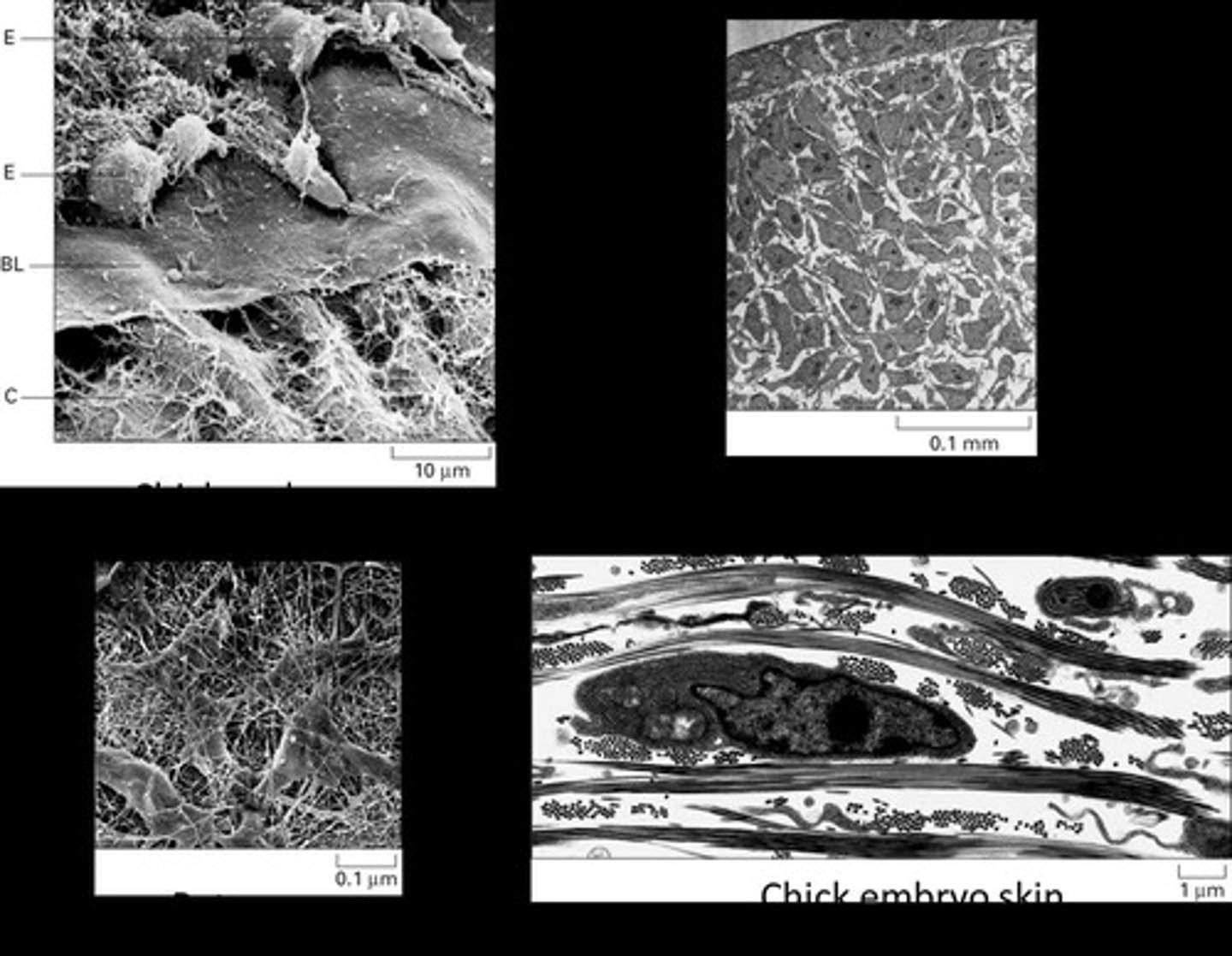
What are the major components of the extracellular matrix?
Glycosaminoglycans (GAGs) and fibrous/adhesive proteins.
How does the composition of the ECM vary?
The composition is dictated by physical and functional requirements such as flexibility, rigidity, fluidity, strength, and permeability.
What is the significance of integrins in cell adhesion?
Integrins are ECM receptors that mediate cell adhesion and signaling.
What are anti-integrin drug types used for?
They are used for anti-thrombotic effects and to target leukocyte rolling in anti-inflammatory therapies.
What is the difference between normal and oncogenically-transformed MDCK cells in terms of adhesion?
Normal MDCK cells undergo apoptosis upon cell damage, while oncogenically-transformed MDCK cells do not.
What is the role of fibroblasts in the ECM?
Fibroblasts synthesize and organize the ECM, contributing to loose connective tissue.
How do cells influence the ECM?
Cells synthesize, excrete, and organize major components of the ECM.
What is the dynamic nature of the ECM?
The ECM undergoes assembly, modeling, synthesis, excretion, remodeling, and repair.
What is the impact of cytoskeletal drugs on intermediate filaments?
There are very few drugs targeting intermediate filaments, with ammonium thioglycolate being one.
What is the significance of the cytoskeleton in determining cell shape?
The cytoskeleton is a major determinant of cell shape due to its structural properties.
What are the characteristics of glycosaminoglycans (GAGs)?
GAGs are long unbranched polysaccharides that play a key role in the ECM's physical properties.
What is the relationship between cell adhesion and cancer therapies?
Many cancer chemotherapies exploit the mechanism of action related to cell damage and subsequent apoptosis influenced by cell-ECM adhesion.
What is the function of the nuclear lamina?
The nuclear lamina, formed by intermediate filaments, provides structural support to the nucleus.
What are the two classes of microtubule-targeting drugs?
Depolymerizers and stabilizers that affect microtubule dynamics.
What are Glycosaminoglycans (GAGs)?
Unbranched chains of disaccharide-repeats that can be 60-1000's sugars long.
What are the four major groups of Glycosaminoglycans (GAGs)?
Hyaluronic acid, chondroitin, heparan, and keratan.
What is the charge and hydration property of Glycosaminoglycans (GAGs)?
They are highly charged (anionic) and easily & heavily hydrated.
What is one of the main functions of Glycosaminoglycans (GAGs) in the extracellular matrix?
They form a low-density 'gel' that fills the bulk of space in most ECMs, allowing passage of small molecules while withstanding compression.
Why are Glycosaminoglycans (GAGs) considered poor drug targets?
Because of their low complexity, they have low specificity.
What are some therapeutic uses of Heparin?
Heparin is used as an anticoagulant and has potential anti-cancer and anti-inflammatory properties.
What therapeutic role does Chondroitin play?
Chondroitin is used as a treatment for osteoarthritis.
What role do fibrous/adhesive proteins play in the extracellular matrix?
They add tensile strength, elasticity, and resilience to the ECM.
How do fibrous proteins and GAGs relate to construction materials?
Fibrous proteins and GAGs can be compared to rebar and concrete, respectively, in providing structural integrity.
What is the general molecular weight comparison between GAGs and fibrous/adhesive proteins?
Fibrous/adhesive proteins generally have a smaller volume/molecular weight than GAGs.
What is the significance of GAGs in modulating secreted proteins?
GAGs bind and modulate the activity and diffusion of secreted proteins like bFGF, TGFb, and cytokines.
What role do fibrous/adhesive proteins play in the extracellular matrix (ECM)?
They add tensile strength, elasticity, and resilience to the ECM, similar to rebar in concrete.
What is the primary protein of the extracellular matrix?
Collagen, which comprises over 20 types grouped into about 5 categories and accounts for approximately 1/4th of the protein mass.
What is the structural composition of collagen?
Collagen consists of three α-chains forming a triple helix.
What is the signature sequence of collagen?
The signature sequence is [Gly-X-Y]n, where X and Y can be various amino acids.
What happens to proline and lysine in collagen synthesis?
Proline can be hydroxylated to hydroxyproline by prolyl hydroxylase, and lysine can be hydroxylated to hydroxylysine by lysyl hydroxylase.
What are the three major groups of collagen?
1) Fibrillar (Col I, II, III), 2) Fibril-associated (Col XII, Col IX), 3) Network-forming (Col IV, VII).
What is the function of fibrillar collagen?
Fibrillar collagen (Col I, II, III) serves as major tension-bearing structures arranged according to tissue function.
How are fibrils oriented in different tissues?
In tendons, fibrils are arranged parallel; in skin, they are arranged in a cross-hatch pattern.
What are some conditions associated with mutations in collagen?
Mutations can lead to osteogenesis imperfecta (Col I), chondroplasias (Col II), and Ehlers-Danlos syndrome (Col III).
What is the role of fibril-associated collagen?
Fibril-associated collagen (e.g., Col XII and Col IX) facilitates fibril-fibril and fibril-ECM associations with interrupted triple helices.
What is the significance of network-forming collagen?
Network-forming collagen (e.g., Col IV, VII) creates flexible, cross-hatched sheets that contribute to the basal lamina.
What is fibrinogen and its role in the extracellular matrix?
Fibrinogen is a soluble, trimeric glycoprotein that circulates in blood and is converted to fibrin by thrombin during tissue injury, forming blood clots.
What are the two main functions of adhesive proteins in the ECM?
1) Structural: they add tensile strength and resilience; 2) Cellular: they provide positional and morphological cues that influence cell function.
What is the importance of hydroxylysine in collagen?
Hydroxylysine (Lys-OH) is important for collagen stability and function.
What is the relationship between collagen and GAGs?
Collagen interacts specifically with glycosaminoglycans (GAGs), promoting the ECM's structural network.
What is the function of the basal lamina?
The basal lamina, formed by network-forming collagen, provides structural support and flexibility in tissues.
How does collagen contribute to the extracellular matrix's overall function?
Collagen contributes to the ECM's structural integrity and modulates cell behavior through specific interactions.
What is the significance of the 'FACIT' collagen?
'FACIT' stands for Fibril-associated collagen with interrupted triple helix, which aids in ECM organization.
What are the components of the soluble extracellular matrix?
The soluble extracellular matrix includes proteins like fibrinogen, which play roles in clotting and tissue repair.
How does the ECM influence cell behavior?
The ECM provides context-specific cues that direct cell adhesion and modulate cell behavior.
What is the role of thrombin in the extracellular matrix?
Thrombin converts fibrinogen into fibrin, facilitating blood clot formation during tissue injury.
How does collagen structure relate to its function in tissues?
The arrangement and type of collagen fibrils are tailored to the mechanical demands of specific tissues, such as tendons and skin.
What are integrins?
A family of heterodimeric transmembrane glycoproteins that serve as principal receptors for ECM proteins and link the ECM to the intracellular cytoskeleton.
What is the structure of integrins?
Integrins are non-covalently linked glycoprotein heterodimers consisting of one alpha (a) chain and one beta (b) chain.
What ions are required for ligand-binding in integrins?
Extracellular Ca2+ or Mg2+.
How does the affinity of integrins for ECM ligands change?
The affinity can be regulated, allowing cells to control the binding between integrins and the ECM.
What is the typical affinity of integrins for ECM ligands?
Typically low, but interactions are numerous and strong yet reversible.
How many alpha and beta subunits do integrins have in mammals?
Approximately 18 alpha and 8 beta subunits combine to form over 24 integrins.
What determines the specificity of integrins?
The combination of alpha and beta subunits determines specificity for ECM ligands, cytoskeletal partners, and the consequences of adhesion.
What is meant by 'degenerate specificity' in integrins?
One ECM protein can bind to several integrin pairs, and one integrin pair can bind to multiple ECM proteins.
What are some ligands that integrins can bind to?
Integrins can bind to vitronectin (Vn), fibronectin (Fn), thrombospondin (Tsp), osteopontin (OstP), and von Willebrand factor (vWF).
What are the two main functions of integrins?
(1) Anchor cells to various extracellular moorings and (2) communicate the specific nature of the outside of the cell to the inside.
What is the expression pattern of integrins?
Integrin expression is cell type-specific, with different integrins present on different cell types.
Give an example of a specific integrin and its cell type.
The integrin a7b1 is specifically expressed on myocytes.
What is the significance of specific integrin-ligand interactions?
Specific integrin, ECM, and cell combinations lead to specificity in cellular interactions.
What does ADAM stand for in the context of integrins?
A disintegrin and metalloprotease.
What is the full name of B. burgdorferi?
Borrelia burgdorferi.
What is the full name of B. pertussis?
Bordetella pertussis.
What does Bsp refer to?
Bone sialic protein.
What does C. albicans refer to?
Candida albicans.
What does Chad refer to?
Chondroadherin.
What does Cyr61 stand for?
Cysteine-rich angiogenic protein 61.
What does Co refer to in the context of integrins?
Collagen.